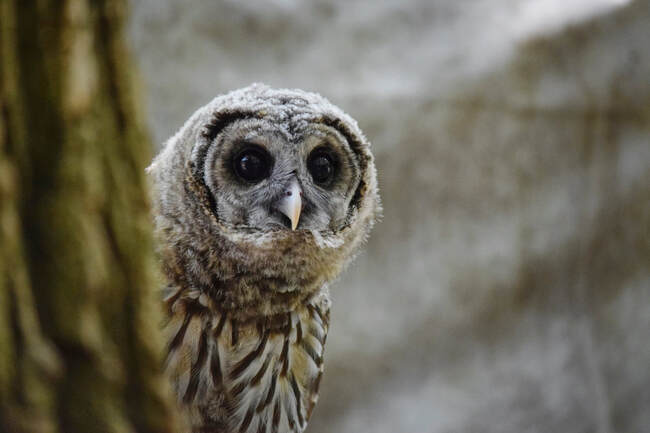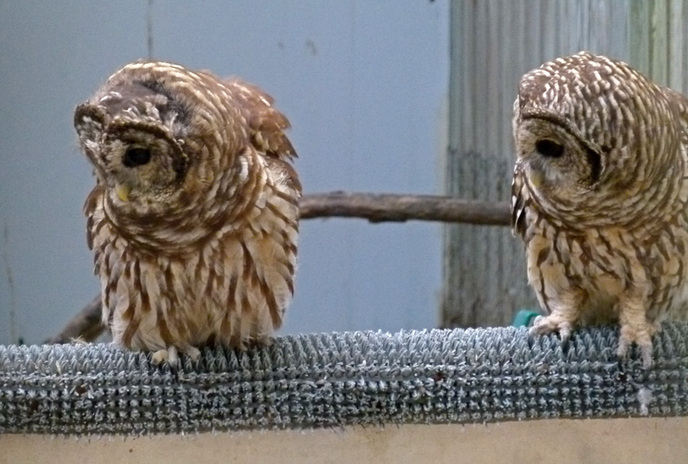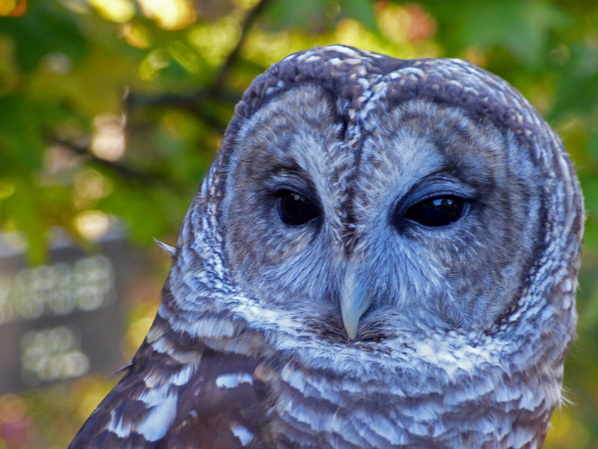BARRED OWLS
Barred Owls are found in the Eastern half of the United States, where they prefer mature oak woods, stands of mixed hardwoods and conifers and swamps with a lack of underbrush, thick dense woods. They are mostly sedentary birds, who form permanent pair bonds and have permanent territories that are defended throughout the year. During courtship the male gives a wide variety of calls while pursuing the female, and then he will perch near her, raising first one wing, then the other, then both together.
Known as the "True Hoot Owl," the Barred Owl makes more different kinds of calls than any other owl in North America. The most common call sounds like "Who cooks for you? Who cooks for you allll?" and can be used to call in the owls. Others sound like whistling, baying hounds, barking dogs, a human screaming in agony, cackling, yells and maniacal laughter. Often many owls will begin calling in a pattern that resembles humans singing in a round. Adult male Wild Turkeys will gobble in response to the hoot of a Barred owl as a warning for it not to attack its young.
Barred Owls eat a variety of small mammals, especially rodents, and a wide variety of reptiles, including frogs, lizards, snakes and salamanders. They will also take insects, birds up to the size of flickers, Screech Owls and Long-eared Owls. Sometimes they may wade knee deep in water to catch fish with their feet. At RROKI, we always give young owls a chance to practice hunting before they are released by putting live mice in a big sandbox in the flight cage. The chicks are fascinated with the mice!
Barred Owls eat a variety of small mammals, especially rodents, and a wide variety of reptiles, including frogs, lizards, snakes and salamanders. They will also take insects, birds up to the size of flickers, Screech Owls and Long-eared Owls. Sometimes they may wade knee deep in water to catch fish with their feet. At RROKI, we always give young owls a chance to practice hunting before they are released by putting live mice in a big sandbox in the flight cage. The chicks are fascinated with the mice!
Unlike other raptors whose primary tools are their feet and talons, the Barred Owl has its power more evenly distributed between its talons and beak. Their hooked beak is incredibly strong, capable of cracking the shell on a turtle, while their feet are not quite as strong as other raptors'. Barred Owls have a very visible nictitating membrane, appearing as a blue film sliding over their brown eye from a distance. It is actually a third eyelid that moves diagonally across the eye from the upper corner, which all birds have. The membrane is a translucent, protective covering that the owls use when flying through thick woods and feeding young to prevent sticks or overly eager youngsters from scratching the eye.
Barred Owls have begun expanding into the Pacific Northwest due to their dependence on old growth forests for nest sites. The Spotted Owl is native to this area, and sometimes they interbreed, producing a "Sparred Owl." There is talk of shooting the Barred Owls to eliminate them in this territory since the Spotted Owls are declining in numbers.
Barred Owls have begun expanding into the Pacific Northwest due to their dependence on old growth forests for nest sites. The Spotted Owl is native to this area, and sometimes they interbreed, producing a "Sparred Owl." There is talk of shooting the Barred Owls to eliminate them in this territory since the Spotted Owls are declining in numbers.
Lockett
Lockett was found by a family in South Carolina as a very tiny chick. The family was unaware of the laws pertaining to Migratory Birds or the MBTA. They took Lockett home and tried to raise him, feeding him worms and crickets. After a very short time they realized this was not going to be as much fun as they thought it was and they took him to a licensed mammal rehabilitator. Mammal rehabbers do not have the license to care for birds and that rehabber transferred the bird to a Raptor Rehabilitator in Rutherford, N.C., Beth Knapp Tyner. Beth fed him nutritious foods and finished raising him but the damage was already done. Lockett was imprinted on people. Imprinting usually occurs during the first 3-6 weeks of a bird's life. It is apparent because the young bird will beg when it hears human voices, as well as, beg and cry when it sees humans. Lockett became an education bird with Wild at Heart Wildlife Rehabilitation and was so imprinted on Beth that he would actually copulate with an old green hat when she wore it. In April 2014 Beth was diagnosed with a terminal disease and asked that RROKI give him a home. He came to live with us in August 2014 and entertains everyone on a daily basis as he is very vocal. All of our guests delight in his antics as he has so many calls and he doesn't hesitate to share them.




